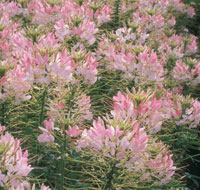New Cleome Releases
New For 2002
Cleome F1 'Sparkler Blush' AAS Flower Winner - This first F1 hybrid Cleome has pastel pink blooms covering full, bushy, upright 3 foot tall plants. (Goldsmith)
 |
Written by Nancy Szerlag in her Annuals For Michigan by Lone Pine Press.
Care For Cleome
The care information provided in this section represents the kind of practical advice is available for all the plants in this web site if you subscribe to the monthly customized newsletter Yardener’s Advisor.
| Care for Cleome | |
|---|---|
| March | Cleomes are easy to grow from seed, either indoors under lights or outdoors in the garden. If you had some in the garden last year, they will likely show up all by themselves. If direct seeding is your choice for Cleome, sow seeds directly into the garden bed 2 to 3 weeks before expected last frost. |
| April | Plant Cleome seedlings purchased at the garden center or nursery, or those you've started indoors, as soon as danger of frost is past and the soil is warm (when night time temperatures stay above 50 degrees). See Yardener’s Helper re: hardening off seedlings before planting outside. Space plants about two feet apart. |
| May | If Cleomes are growing in good soil containing lots of organic material, they want only a light feeding in the spring when the seedlings are set out, about a half a tablespoon of slow-release granular fertilizer per plant. In poor soils use a bit more; one tablespoon of slow-release granular fertilizer per plant. That is all you need for the season. See Choosing Fertilizers in Yardener’s Tool Shed |
| |
Optional task – Cleomes grow best when mulched. As soon as the Cleome seedlings are tall enough, spread a 2 or 3 inch layer of some organic material such as chopped leaves, dried grass or wood chips on the soil around the plants. For more information see the file on Using Mulch |
| June | Optional - Cleomes can use some support to protect them against heavy rain, wind and passers-by. Choose unobtrusive green stakes available at garden centers or find straight, sturdy sticks that are at least as tall as the eventual height of the Cleome plants. |
| |
Optional – Your Cleomes will appreciate, in preparation for the heat of summer, a light feeding of fertilizer using a liquid fertilizer diluted to half strength according to the label. This can be poured into the soil or sprayed right on to the plant. See Choosing Fertilizers in Yardener’s Tool Shed. |
| July | Optional - Cleomes benefit from deadheading. This practice of snipping off the dead blossoms prevents the plants from forming seeds, thus stimulating the production of more blooms. It also keeps the plants looking attractive. |
| October | Your plants will die with the first hard frost. Remove them to the compost pile but keep the beds mulched right through the winter, ready for next year’s plants. This plant will readily reseed itself next year. |
| |
|

